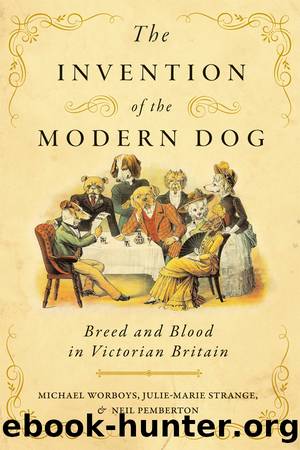The Invention of the Modern Dog by Michael Worboys Julie-Marie Strange and Neil Pemberton

Author:Michael Worboys, Julie-Marie Strange, and Neil Pemberton
Language: eng
Format: epub
Publisher: Johns Hopkins University Press
The only elaboration he made of his schema was with respect to his first point on “quality,” which he described as having to do with “ ‘blood,’ nervous development, vigour, energy, and character.” In the book’s chapter on breeding, Shaw discussed the possibility of other maternal influences or antecedent impression, that is, the physiological and nervous effects of the offspring’s connection with the mother in the womb and through feeding.40
In the last quarter of the nineteenth century, breeders wanting insights into “blood” were referred to a pamphlet published in 1874 by William Tegetmeier, the doyen of fancy poultry breeders, and Dr. William Whytehead Boulton, a general practitioner from Beverley in Yorkshire, who bred cocker spaniels.41 Boulton was famed for having produced a kennel of jet-black spaniels that bred true to color “generation after generation.”42 Experience with black spaniels seems to have been particularly instructive, as another widely quoted expert on breeding was Thomas Jacobs from Newton Abbot, also known for his black spaniels.43 Black spaniels had become popular at dog shows, but their dark coat meant they were hard to spot from a distance and not much used in the field. As a creation of shows, their status was much debated: Were they sporting or nonsporting? Sometimes they were considered a strain, which by the 1880s meant a sub-breed, though at other times they were termed “a mongrel.” Jacobs agreed: “Much has been written and said on the purity of the breed, deprecating the means I have adopted to produce them as calculated to alter a presumed type, and frequent missiles have been hurled at me and my dogs from behind the hedge. But where is the pure-bred Black Spaniel so much talked about? Proof of the existence of the pure-bred one (if ever there was one) has not been forthcoming; like most other sporting dogs, they are the result of different crosses.”44 He went on to argue that, despite the modern fetish for purity, crossbreeding had been and was still essential to improving breeds.
We may keep to one strain for many years, and, in time, call them a distinct breed, but what is the result? To preserve that strain we must continually breed in and in to one family, until we get them difficult to rear, weedy, and devoid of sense, when they become useless for the purpose they are required. Therefore breeders have to resort to the crossing with another family, which may be of a different type or colour; by doing so you raise a great “hubbub” and cry that your dogs are not pure. In spite of these cries I followed my own dictation; my great aim was to improve the breed of Spaniels.45
His use of “resort” confirms that while inbreeding was the norm, outcrossing was accepted to save a strain. Jacobs was not modest—he claimed that his spaniels “eclipse everything I have yet seen”—and yet he was not satisfied. He had further improvement in mind toward an imagined ideal, “the standard I have marked out for my beacon.
Download
This site does not store any files on its server. We only index and link to content provided by other sites. Please contact the content providers to delete copyright contents if any and email us, we'll remove relevant links or contents immediately.
Sapiens: A Brief History of Humankind by Yuval Noah Harari(14166)
Sapiens by Yuval Noah Harari(5264)
Pale Blue Dot by Carl Sagan(4858)
Homo Deus: A Brief History of Tomorrow by Yuval Noah Harari(4777)
Livewired by David Eagleman(3624)
Origin Story: A Big History of Everything by David Christian(3590)
Brief Answers to the Big Questions by Stephen Hawking(3319)
Inferior by Angela Saini(3209)
Origin Story by David Christian(3117)
The Gene: An Intimate History by Siddhartha Mukherjee(3014)
Signature in the Cell: DNA and the Evidence for Intelligent Design by Stephen C. Meyer(2996)
The Evolution of Beauty by Richard O. Prum(2914)
Aliens by Jim Al-Khalili(2764)
How The Mind Works by Steven Pinker(2695)
A Short History of Nearly Everything by Bryson Bill(2579)
Sex at Dawn: The Prehistoric Origins of Modern Sexuality by Ryan Christopher(2441)
From Bacteria to Bach and Back by Daniel C. Dennett(2423)
Endless Forms Most Beautiful by Sean B. Carroll(2402)
Who We Are and How We Got Here by David Reich(2375)
